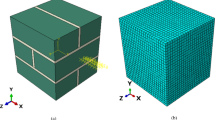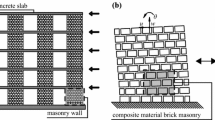Abstract
Due to differences in the properties of composition materials and construction techniques, unreinforced masonry is characterized by low strength, anisotropy, nonuniformity, and low ductility. In order to accurately simulate the mechanical behavior of unreinforced brick masonry walls under static and dynamic loads, a new elastoplastic damage constitutive model was proposed and the corresponding subroutine was developed based on the concrete material constitutive model. In the proposed constitutive model, the Rankine strength theory and the Drucker-Prager strength theory were used to define the tensile and compressive yield surface function of materials, respectively. Moreover, the stress updating algorithm was modified to consider the tensile plastic permanent deformation of masonry materials. To verify the accuracy of the proposed constitutive model, numerical simulations of the brick masonry under monotonic and cyclic uniaxial tension and compression loads were carried out. Comparisons among the numerical and theoretical and experimental results show that the proposed model can properly reflect the masonry material mechanical properties. Furthermore, the numerical models of four pieces of masonry walls with different mortar strengths were established. Low cyclic loadings were applied and the results show that the proposed constitutive model can properly simulate the wall shear failure characteristics, and the force-displacement hysteretic curves obtained by numerical simulation are in good agreement with the tests. Overall, the proposed elastic-plastic damage constitutive model can simulate the nonlinear behavior of unreinforced brick masonry walls very well, and can be used to predict the structural response of masonry walls.
Similar content being viewed by others
References
Abo-El-Ezz A, Nollet MJ and Nastev M (2013), “Seismic Fragility Assessment of Low-Rise Stone Masonry Buildings,” Earthquake Engineering and Engineering Vibration, 12(1): 87–97.
Addessi D, Marfia S and Sacco E (2002), “A Plastic Nonlocal Damage Model,” Computer Methods in Applied Mechanics and Engineering, 191(13): 1291–1310.
Addessi D, Marfia S, Sacco E and Toti J (2014), “Modeling Approaches for Masonry Structures,” Open Civ. Eng. J, 8(1): 288–300.
Addessi D and Sacco E (2012), “A Multi-Scale Enriched Model for the Analysis of Masonry Panels,” International Journal of Solids and Structures, 49(6): 865–880.
Agüera ND, Tomello ME and Frau CD (2016), “Structural Response of Unreinforced Masonry Walls,” Journal of Civil Engineering and Architecture, 10: 219–231.
Aref AJ and Dolatshahi KM (2013), “A Three-Dimensional Cyclic Meso-Scale Numerical Procedure for Simulation of Unreinforced Masonry Structures,” Computers and Structures, 120(2): 9–23.
Bellis MLD and Addessi D (2011), “A Cosserat Based Multi-Scale Model for Masonry Structures,” International Journal for Multiscale Computational Engineering, 9(5): 543–563.
Berto L, Saetta A, Scotta R and Vitaliani R (2002), “An Orthotropic Damage Model for Masonry Structures,” International Journal for Numerical Methods in Engineering, 55(2): 127–157.
Bretas EM, Lemos JV and Lourenço PB (2014), “A DEM Based Tool for the Safety Analysis of Masonry Gravity Dams,” Engineering Structures, 59(2): 248–260.
Cervera M, Oliver J and Manzoli O (1996), “A Rate-Dependent Isotropic Damage Model for the Seismic Analysis of Concrete Dams,” Earthquake Engineering and Structural Dynamics, 25(9): 987–1010.
Faria R, Oliver J and Cervera M (1998), “A Strain-Based Plastic Viscous-Damage Model for Massive Concrete Structures,” International Journal of Solids and Structures, 35(14): 1533–1558.
Faria R, Oliver J and Cervera M (2000), “On Isotropic Scalar Damage Models For The Numerical Analysis of Concrete Structures,” CIMNE, Monograph PI198, Barcelona.
Faria R, Oliver J and Cervera M (2004), “Modeling Material Failure in Concrete Structures Under Cyclic Actions,” Journal of Structural Engineering, 130(12): 1997–2005.
Fu Qiushi and Qian Jiang (2018), “Seismic Analysis of Masonry Structures Based on Anisotropic Damage Constitutive Model,” Chinese Journal of Computational Mechanics, 35(6): 4–9. (in Chinese)
Galvez F, Giaretton M, Abeling S, et al. (2018), “Discrete Element Modeling of a Two Storey Unreinforced Masonry Scaled Model,” 16th European Conference on Earthquake Engineering.
Ge Dongdong, Du Chunbo, Miao Qisong and Chen ** (2021), “Seismic Collapse Simulation of Existing Masonry Buildings with Different Retrofitting Techniques,” Earthquake Engineering and Engineering Vibration, 20(1): 127–139. https://doi.org/10.1007/s11803-021-2010-2.
Gong Maosheng, Zuo Zhanxuan, Sun **g, He Riteng and Zhao Yinan (2021), “Influence of the Column-to-Beam Flexural Strength Ratio on the Failure Mode of Beam-Column Connections in RC Frames,” Earthquake Engineering and Engineering Vibration, 20(2): 441–452. https://doi.org/10.1007/s11803-021-2030-y
Hatzigeorgiou G, Beskos D, et al. (2001), “A Simple Concrete Damage Model for Dynamic FEM Application,” International Journal of Computational Engineering Science, 2(2): 267–286.
Karapitta L, Mouzakis H and Carydis P (2011), “Explicit Finite-Element Analysis for the In-Plane Cyclic Behavior of Unreinforced Masonry Structures,” Earthquake Engineering and Structural Dynamics, 40(2): 175–193.
Lee J and Fenves GL (2001), “A Return-Map** Algorithm for Plastic-Damage Models: 3-D and Plane Stress Formulation,” International Journal for Numerical Methods in Engineering, 50(2): 487–506.
Lemaitre J (2000), A Course on Damage Mechanics, Berlin: Springer-Verlag.
Lemos JV (2007), “Discrete Element Modeling of Masonry Structures,” International Journal of Architectural Heritage, 1(2): 190–213.
Li Jie and Wu Jianying (2005), “Elastoplastic Damage Constitutive Model for Concrete Based on Damage Energy Release Rates, Part I: Basic Formulations,” China Civil Engineering Journal, 38(9): 14–20. (in Chinese)
Li **ao and Tong Genshu (2021), “Static and Dynamic Inelastic P−Δ Effect for Seismic Design,” Earthquake Engineering and Engineering Vibration, 20(3): 645–660. https://doi.org/10.1007/s11803-021-2044-5
Liu Yongbin, Dai Junwu, Yang Yongqiang and Jiang Tao (2020), “Novel Uniaxial Concrete Constitutive Model Considering Bond-Slip Effect,” Earthquake Engineering and Engineering Vibration, 19(3): 649–668. https://doi.org/10.1007/s11803-020-0587-5.
Lotfi HR and Shing PB (2016), “Interface Model Applied to Fracture of Masonry Structure,” Journal of Structural Engineering, 120(1): 63–80.
Lourenço PB (2009), “Recent Advances in Masonry Modelling: Micromodelling and Homogenisation,” Computational and Experimental Methods in Structures Multiscale Modeling in Solid Mechanics, pp. 251–294.
Lourenço PB and Rots JG (1997), “Multisurface Interface Model for Analysis of Masonry Structures,” Journal of Engineering Mechanics, 123(7): 660–668.
Macorini L and Izzuddin BA (2011), “A Non-Linear Interface Element for 3D Mesoscale Analysis of Brick-Masonry Structures,” International Journal for Numerical Methods in Engineering, 85(12): 1584–1608.
Massart TJ, Peerlings RHJ and Geers MGD (2010), “An Enhanced Multi-Scale Approach for Masonry Wall Computations with Localization of Damage,” International Journal for Numerical Methods in Engineering, 69(5): 1022–1059.
Oliver J, Cervera M, Oller S and Lubliner J (1990), “Isotropic Damage Models and Smeared Crack Analysis of Concrete,” Proceedings of the Second International Conference on Computer Aided Analysis and Design of Concrete Structures, Zell am See, pp. 945–957.
Oliveira DV and Lourenço PB (2004), “Implementation and Validation of a Constitutive Model for the Cyclic Behaviour of Interface Elements,” Computers and Structures, 82(17): 1451–1461.
Pelà L, Cervera M and Roca P (2011), “Continuum Damage Model for Orthotropic Materials: Application to Masonry,” Computer Methods in Applied Mechanics and Engineering, 200(9–12): 917–930.
Petracca M (2016), “Computational Multiscale Analysis of Masonry Structures,” PhD Thesis, Polytechnic University of Catalonia.
Roca P, Cervera M, Gariup G and Pelà L (2010), “Structural Analysis of Masonry Historical Constructions, Classical and Advanced Approaches,” Arch Comput Methods Eng., 17: 299–325.
Sacco E and Toti J (2010), “Interface Elements for the Analysis of Masonry Structures,” International Journal for Computational Methods in Engineering Science and Mechanics, 11: 354–373.
Sachin B Kadam, Yogendra Singh and Li Bing (2020), “Seismic Fragility Reduction of an Unreinforced Masonry School Building Through Retrofit Using Ferrocement Overlay,” Earthquake Engineering and Engineering Vibration, 19(2): 397–412. https://doi.org/10.1007/s11803-020-0569-7
Sarhosis V and Lemos JV (2018), “A Detailed Micro-Modelling Approach for the Structural Analysis of Masonry Assemblages,” Computers and Structures, 206(AUG.): 66–81.
Schlegel R and Rautenstrauch K (2004), “Numerical Modeling of Discrete Materials-Failure Analysis of Masonry Shear Walls,” Bautechnik, 80(7): 15–18.
Shang Qingxue, Guo **aodong, Li Quanwang, Xu Zhen, **e Linlin, Liu Chaofeng, Li Jichao and Wang Tao (2020), “A Benchmark City for Seismic Resilience Assessment,” Earthquake Engineering and Engineering Vibration, 19(4): 811–826. https://doi.org/10.1007/s11803-020-0597-3
Simo JC and Ju JW (1987), “Strain- and Stress-Based Continuum Damage Models, I. Formulation,” International Journal of Solids and Structures, 23(7): 821–840.
Simo JC and Ju JW (1989), “Strain- and Stress-Based Continuum Damage Models, II. Computational Aspects,” International Journal of Solids and Structures, 23(7): 841–869.
Sun Baitao and Zhang Guixin (2018), “Study on Vulnerability Matrices of Masonry Buildings of Mainland of China,” Earthquake Engineering and Engineering Vibration, 17(2): 251–259.
Tang Caoming, Luo Rui, Cheng Shaoge and Huang Baodong (2017), “Experimental Study of Seismic Performance of Low Strength Masonry Walls Reinforced with One-Side Cement Mortar Splint,” Journal of Building Structures, 38(10): 157–167. (in Chinese)
Toti J, Gattulli V and Sacco E (2015), “Nonlocal Damage Propagation in the Dynamics of Masonry Elements,” Computers and Structures, 152(May): 215–227.
Valliappan S, Yazdchi M and Khalili N (1999), “Seismic Analysis of Arch Dams — A Continuum Damage Mechanics Approach,” International Journal for Numerical Methods in Engineering, 45(11): 1695–1724.
Wu Jianying, Li Jie and Faria R (2006), “An Energy Release Rate-Based Plastic-Damage Model for Concrete,” International Journal of Solids and Structures, 43(3–4): 583–612.
Yang Weizhong Y, Cao Wenwen and Wang Qian (2013), “Research on Stochastic Damage Constitutive Relation of Masonry Subjected to Axial Loading,” Journal of Zhengzhou University (Natural Science Edition), 45(2): 109–114. (in Chinese)
Yi Weijian and Li Peng (2006), “Experiments Study of Masonry Construction Constitutive Relationship Under Axial Compression,” Sciencepaper Online, 1(2). (in Chinese)
Yue Jianguang, Qian Jiang, Wu Kai, et al. (2012), “A Modified Plastic Damage Model for Masonry Structure,” Chinese Quarterly of Mechanics, 33(1): 146–152. (in Chinese)
Zheng Nina, Li Yingmin and Pan Yi (2011), “Seismic Behavior of Low Masonry Structure with Core-Tie-Columns,” Journal of Southwest Jiaotong University, 46(1): 24–29, 55. (in Chinese)
Acknowledgement
This work is supported by the National Key Research and Development Program of China (2018YFC1504400 and 2019YFC1509301), Natural Science Foundation of China (52078471), and Scientific Research Fund of Institute of Engineering Mechanics, China Earthquake Administration (Grant No. 2019EEEVL0402).
Author information
Authors and Affiliations
Corresponding author
Additional information
Supported by: National Key Research and Development Program of China under Grant Nos. 2018YFC1504400 and 2019YFC1509301, Natural Science Foundation of China under Grant No. 52078471, and Scientific Research Fund of Institute of Engineering Mechanics, China Earthquake Administration under Grant No. 2019EEEVL0402
Rights and permissions
About this article
Cite this article
Wu, B., Dai, J., Bai, W. et al. Triaxial elastoplastic damage constitutive model of unreinforced clay brick masonry wall. Earthq. Eng. Eng. Vib. 22, 157–172 (2023). https://doi.org/10.1007/s11803-023-2151-6
Received:
Accepted:
Published:
Issue Date:
DOI: https://doi.org/10.1007/s11803-023-2151-6




